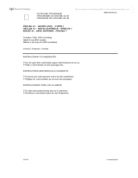The poem takes place in a church, in a funeral set-up, with flocking birds in the sky. We understand this because of the phrase “so crammed church roof and belfry.” I can comprehend that it is a funeral because the poet relates the hibernation of the birds to a 70 year old woman. The writer also illustrates a picture of a myriad of birds as he writes “There must have been 10,000 there or more.”
Even though he feels immense loneliness and sadness after the passing on of his mother, he is not yet ready to follow her, and must remain in “reality,” hence he is “the last soul still unhatched”. The poem begins in the first person as the poet describes his experiences as a boy. We learn that his mother taught him to "count to a ragged 20 but no higher". When he was still a boy, the sheer number of birds perching on the belfry exceeded his counting abilities, “cramming church roof and belfry, cross and spire”. At this later stage in his life, however, it is not due to his counting skills that he cannot count but due to the sheer immeasurable quantity and their uncontrollable, free nature, unable to be caged or catalogued. Their numbers were so great that “their final taking off blacked Beeston’s sky”. These birds feature throughout the poem, creating a sense of activity and movement and dramatic symbolism. Here, the black sky symbolises the unfortunate and sad mood.
While the “flocking birds” represent what the man is looking at and his memories of them as a boy, they also have a metaphorical meaning, symbolizing the life and death of his mother. The crossroad of reality and imagery appears in line six with the following alliteration: “picketed piercingly the passing of each day”. The power of the repeated ‘P’ sound reflects the sound of the birds’ cries. In the poet’s mind, each bird also represents a single day in the life of his mother. In fact, as the second stanza progresses, the birds only exist to measure the accumulated days in the life of the man’s mother. Her attraction towards the birds is completed when they suddenly depart, taking her life with them.
The shock of the mother’s death is so deep that the first person used throughout the first two stanzas is obliterated and transformed into the third person in the last stanza, the man suddenly being referred to as “her son”. The third stanza also dramatizes the metaphorical blend of his mother and the birds. Death becomes the “wings of night”, her life becomes “the flocking days”. Her departure from the earth is an effusion, a release, of all her physical experiences which are “soaring” away. So significant was she to her son that her departing life “blocked the light”. In the final line the son becomes an unhatched egg/soul left behind “in the clutch” or the nest.
Having come to associate the birds with his mother, his memories of her are immediately summoned whenever he sees them. She may be dead but she lives on in his memories of the birds. At first they “shrilly hailed the first new light they saw,” greeting the new day in what initially seems to be an irritating way because they are portrayed as having loud, high-pitched cries that are not particularly pleasant to the ears. However, after his mother dies, and they leave too, he comes to see them in a different light, after they “soared away.” His opinion of them has now changed and he sees them as graceful and elegant creatures. This imagery also successfully implies life after death, and the setting of the poem becomes important when looked at in this light. A church is a place of peaceful meditation, praying and holiness, a place where the boundaries between the physical and the spiritual, the barriers between life and death, merge. For these reasons it becomes the nest that hatches souls into the heavens.
Even though the birds, and the man’s mother with them, fly “beyond all sight, hearing, taste, smell, touch” they do not fly beyond love or memories, instead leaving a path for the man to follow when it is his turn to be “hatched”. The lesson the mother taught her son began with counting, but ended with a realization of life after death and the possibility of living, in spirit, for infinity.
Words - 921







